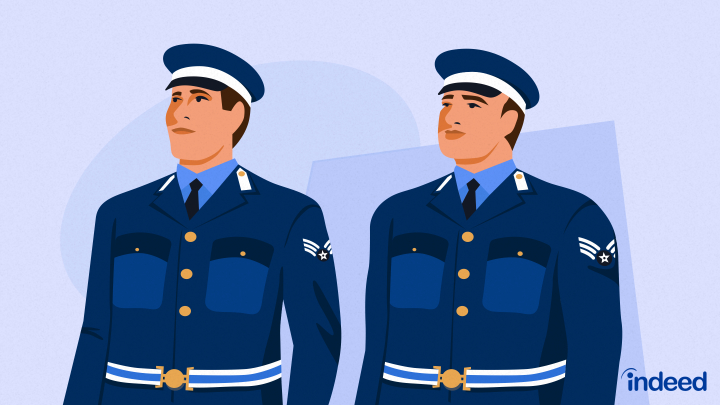Guide to US Air Force Officer Ranks: Types and Definitions
Updated April 9, 2024

What are the U.S. Air Force officer ranks?
The U.S. Air Force officer ranks are classifications that differentiate officers from enlisted personnel and help individuals determine the appropriate officer to contact in various situations. There are several ranks within the officer field that differentiate the experience and leadership responsibilities the military expects an officer to perform. Here are the commissioned officer groups in the U.S. Air Force:Company grade officers
Company grade officers are personnel in pay grades Officer-1 to Officer- 3, or O-1 to O-3. Company grade officers can serve in more administrative or small group leadership roles to support their flight of personnel. Some O-3 officers may have authority over a flight of personnel, which can include two or more aviators.Related: Career Paths in the Air ForceField grade officers
Field grade officers are officers in pay grades O-4 to O-6. Field grade officers have more areas of responsibility and may see an increase in the personnel they train and maintain accountability for during their assignments. They might command a squadron, group or wing of aviators that can vary in personnel size.Related: The Most In-Demand U.S. Air Force JobsGeneral officers
General officers are officers in pay grades O-7 to O-10. They're the highest ranking of the commissioned officers, and they oversee the operations of commands composed of various wings. Typically, general officers can attain the rank of O-8. The ranks of O-9 and above are either assignment-specific, such as working in the Department of Defense or awarded during a wartime mission.When an officer leaves these positions or returns from war, they return to their previous rank. The highest level an officer can achieve when not in combat or high command is O-8, while the president selects the remaining ranks, which are temporary.Related: Commissioned vs. Non-Commissioned Officer: What's the Difference?Officer ranks vs. pay grades
Traditionally, commissioned officers make more money than enlisted personnel. The pay difference correlates with the requirements of each rank and can include both formal training, such as a college degree, or the skill set required. An officer's rank reflects their level of responsibility, while an officer's pay grade is an administrative classification to standardize compensation across military services.Often, an officer's pay grade rises with their rank. Officers also pay for many services, which are available to the enlisted personnel for free. These services include things like uniform expenses and meals on base.Related: A Complete Guide to Military PayGet recommendations for your resume in minutes
Types of U.S. Air Force officer ranks
There are 10 different U.S. Air Force officer ranks that have varying levels of responsibilities and expectations. Each commissioned officer starts as a second or first lieutenant and earns promotions as they achieve certain training and experience in the military and in each rank. The commissioning rank of second or first lieutenant depends on the educational training of the officer involved. Medical offices and lawyers typically start their service as a first lieutenant, while officers possessing a general college degree typically start as a second lieutenant. Here's a list of the U.S. Air Force officer ranks:1. Second lieutenant
Second lieutenant is the rank given to newly commissioned officers. The responsibilities of each second lieutenant vary between career fields, but they generally serve in administrative support roles to higher-level officers. Some aviators may skip this rank due to prior enlisted service and experience. If an individual has specific skills or knowledge, such as radiography , they can surpass this rank.Related: 11 of the Highest-Paying Air Force Jobs2. First lieutenant
First lieutenants have similar responsibilities as second lieutenants but have a higher level of pay and leadership responsibilities. Certain first lieutenants may take the responsibility of supervising a flight of personnel. These professionals can also be in charge of mentoring and developing second lieutenants, creating plans for the professional development of specific groups of personnel or larger groups of aviators.Some fields in the U.S. Air Force require additional training, such as intelligence gathering, so for these officers, completion of the required course work and demonstrated skill mastery is a critical training component. When the military selects certain first lieutenants to be a part of the flying or intelligence career field, those professionals attend more training sessions until they're proficient in the new responsibilities of their roles.3. Captain
A captain is a typical rank that a professional achieves after serving four years as an officer. Captains generally serve as flight commanders, but their responsibilities can vary between career fields or areas of assignment. Certain career fields, such as medical or legal, may grant an officer the rank of captain upon commissioning due to the extensive education requirements of those roles.Related: How To Become an Air Force Pilot4. Major
Officers generally achieve the rank of major after 10 years of service. These officers typically see an increase in responsibilities and become an integral part of the planning and execution of training and missions. When selected for this rank, the individual has proven experience in both leading groups of personnel and planning complex training plans.They must demonstrate that they possess the ability to create a mission statement and develop plans accordingly. They may become more involved with the administrative functions of a squadron or a wing. In certain career fields, they may also become a squadron commander, overseeing the operations of a career field at their assigned station.Related: Best Jobs in the U.S. Air Force5. Lieutenant colonel
Lieutenant colonel is a rank given to recognized majors with specific accomplishments. The individuals selected for this rank have succeeded ahead of their cohort group. A lieutenant colonel is a rank given to those promoted from major. Professionals usually achieve this rank near their 20-year mark in the military. Lieutenant colonels are typically squadron commanders in many flying, nonflying and medical career fields. Outside of becoming a squadron commander, they may serve as a staff member at a wing level or to a general.Related: 13 Medical Jobs To Consider in the U.S. Air Force6. Colonel
Colonel is the highest field grade officer rank. The military awards professionals with this rank who have consistently met their requirements in both training and educational requirements. Typically, this happens around 22 years of service. Colonels are usually group or wing commanders and can make decisions that affect the overall mission of a base. Some colonels may consider becoming a commander for an officer training school or military college and plan to pursue post-graduate credentials.7. Brigadier general
Brigadier generals are career officers that usually serve as wing or base commanders. Larger wings and bases can have brigadier generals in charge instead of colonels, but they may also serve in high-level staff positions. Brigadier generals perform and oversee administrative and operational functions of the base and can make decisions that affect the mission of that base. They have specific areas of expertise to facilitate their decision-making and ensure the achievement of the U.S.Air Force mission.Related: FAQ: Can You Switch Jobs in the Air Force? (And How It Works)8. Major general
Major generals serve in a variety of high-level command positions and can expect to have around 10,000 personnel under their command. The U.S. Air Force expects major generals to manage the administrative and operational functions of a base effectively and ensure they achieve the mission of that base daily. They may also act as a liaison between groups in the U.S. Air Force, such as the Reserves or National Guard.Related: U.S. Air Force Reserve Physical Requirements9. Lieutenant general
Lieutenant generals serve with a larger group of personnel and can cover multiple geographic locations. They may also work as part of the government in positions advising the president or secretary of defense in worldwide operations, in high-command positions supervising numbered U.S. Air Force commands or in high-level headquarters positions.At any given time, there are no more than 25% of officers in the U.S. Air Force who have two stars or more. Individuals selected for this rank require time and proficiency in their respective areas and nomination and support of multiple formal organizations.Related: Military Careers: A Definitive Guide10. General
The president awards the rank of general to those with extensive service and recognition in the U.S. Air Force. This rank is the highest commissioned rank an officer can hold, and it's for individuals in the top military positions in the Pentagon. They serve in command positions or can occupy treaty organizations, such as the North Atlantic Treaty Organization (NATO).
Military & intelligence
Explore more articles
- 6 Health Information Management Careers (including salaries)
- The Pros and Cons of Working for a Startup
- 10 Pros and Cons of Being an Art Therapist (Plus Salary)
- How To Become a Genetic Engineer
- What Does a Hospital Administrator Do? (Duties and Salary)
- How To Become a Call Center Agent (With Skills and Salary)
- 13 Reasons To Become a Chef: Why You Should Choose This Career
- 32 Careers in Photography
- How To Become a Makeup Artist for Films
- What Does an MDS Coordinator Do? (With Salary Information)
- What Is a Master Plumber? (Plus Steps To Become One)
- How To Become a Firefighter in Ohio (With Steps and Skills)


